Features
You are here
Quebec, First Nations and national liberation

May 11, 2012
On Earth Day this year, hundreds of thousands filled the streets of Montreal, causing some commentators to marvel at the connection made between the environment and the fight against austerity by Quebec students. But there was another connection made that day: opposition by both the Quebec people and First Nations to the exploitation and selling-off of northern resources to mining companies, in what is known as Plan Nord.
This stands in sharp contrast to the depiction of First Nations and Quebec interests as inevitably opposed to each other, notably in the Oka standoff and in the fight by the James Bay Cree against the Great Whale hydro-electric project in northern Quebec in the 90s. This Earth Day, Cree, Mohawk, and other First Nations contingents marched should-to-shoulder with Quebec artists, students, and trade unionists.
But Quebec and First Nations have long been pitted very consciously against each other in ways that have undermined the legitimate demands of both. In the 90s in particular, the constitutional crisis was used by the federal government to deny any recognition of Quebec as a distinct society on the basis of insincere concern for First Nations rights. The 1995 referendum on Quebec sovereignty was followed by federal threats to partition Quebec in the event of separation, supposedly to protect the Cree.
But the oppression of First Nations, like the national oppression of Quebec, is rooted in the Canadian federal state. The 90s was a time of struggle by First Nations communities from coast to coast, from the standoff at Gustafsen Lake in BC, which was met with federal military intervention, to the occupation of Ipperwash Provincial Park, which resulted in the murder of Dudley George by Ontario Provincial Police. The result of scapegoating Quebec for racism against First Nations was to fuel the rise of the anti-Quebec Reform Party in the 90s, the Party that brought Stephen Harper to prominence.
The history of Quebec’s oppression as a nation dates back to the British conquest and military victory on the Plains of Abraham, but it lived on in the cultural, political and economic backwardness that was imposed on Quebec up until the Quiet Revolution. Until that time in the late 60s, to be francophone in Quebec truly meant being a second-class citizen, without even the right to French as your language of work. Bilingual francophones earned less than unilingual anglophones. Quebec was dominated by an unholy alliance between a wealthy anglophone elite with its own hospitals, schools and universities, and the Catholic Church, which extolled the “quebecois” virtue of suffering in silence.
Even after the Quiet Revolution won secularized public education in French and other language rights, a national consciousness remained, expressed in the “I remember” slogan on Quebec licence plates. The fact that university and college education is such a recent and hard-won right is the reason why it is so valued as a social good – and the main reason why the Quebec student movement has been strong enough to maintain a tuition freeze for the better part of forty years.
The pundits who now crow about Quebec tuition being the lowest in the country would do well to remember this history themselves. They are quick to point out that despite low fees, the university participation rate in Quebec is lower than in Ontario – in order to make the case that high fees don’t inhibit access. In fact, the lower participation rate is itself a legacy of oppression, the result of a very recent history of access to post-secondary education in Quebec.
Writing about Ireland in the 19th century, Karl Marx remarked that a nation that enslaves another can never itself be free. In the 90s English Canadians certainly forged their own chains by embracing the anti-Quebec chauvinism that made Stephen Harper’s career.
But that history is changing. “The Quebec Spring” could now point a way to freedom not only for the Québécois but for First Nations and for workers and students in English Canada as well.
Section:
- Log in to post comments










